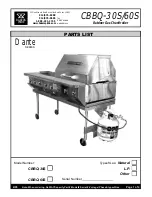
770 mm
670 mm
Surround and Opening
Dim. A:
Dim. B:
Min. 555mm (21 3/4")
Max. 470mm (18 1/2")
Min. 405mm (16")
The shaded area on the face of
the surround is the minimumflat
area required.
Fig. 7 Limiting Dimensions Of
Max. 579mm (22 3/4")
Fig. 6. Typical Instalation
using flexible flue liner
right down to Appliance.
Closure Plate
Rockwool infill
around flexible
liner above closure
Rockwool
insulation
around
Appliance
Vermiculite infill
around Flexible
Liner
Firesurround with
removable metal
closure panels
100mm id single skin
flexible flue pipe
High Temperature
Silicone sealant.
Appliance Connector
Flue fixing brackets
Joint caulked with
glass fibre rope and
sealed with high
temperature silicone
sealant.
65mm
110mm
50mm
50mm
the push on piece of 12 mm bleed tube supplied.
Place the other end of the bleed tube into a suitable
receptacle, and flush out the supply line by turning
on the service valve. When the oil is clean, turn off
the service valve, remove the bleed tube, and re-
attach the flexible tube from the burner. Turn the
service valve back on, check for leaks, and clean up
any spilt oil.
PREPARATION OF FIREPLACE
CENTRAL HEATING SYSTEM
When replacing an existing boiler, remove any fireback
and infill material to expose the builders opening.
The opening must be at least 400 mm deep (when
measured from the front face of the surround,) 600
mm wide (to give access to the boiler connections,) and
650 mm high (to give access to the flue connection.
Ensure that the base of the fireplace is level with the
hearth and that the face of the surround is vertical.
It is necessary to have a small cut out in the fireplace
surround at the bottom left of the opening in order to
bring the oil and electrical supply to the fire. It is also
necessary to have a small cut out at the bottom right of
the opening to clear the air inlet duct. See fig. 7.
The central heating system must comply with BS 5449,
and should be installed in accordance with the current
good practise guidelines as advised by the HVCA.
Central heating design is a large subject which it is not
possible to deal with adequately in this manual. The
points that are particularly relevant to this boiler are
dealt with below.
The heating and hot water system should normally be
fully pumped, although a gravity hot water system may
be used if it already exists.
There are no internal divisions in the boiler, and any
combination of flow and return tappings may be used.
If it is possible then diagonal pairs of tappings should be
used, but pairs on the same side may be used if
required.
The maximum working pressure of the boiler must not
exceed 3 Bar ( 44 psi or a static head of 30m)
In order to prevent a build up of scale and corrosion a
suitable inhibitor should be added to the system.
When replacing an existing boiler the system should
be thoroughly cleaned before connecting the new
boiler.
Fully automatic central heating controls may be used to
give full control of the heating and hot water. When
designing the control system it is important to note that
if the situation can arise where the flow of water
through the boiler is stopped, or substantially reduced,
whilst the burner is still firing, then this can result in the
water in the boiler reaching very high temperatures, or
even boiling, before the boiler thermostat can sense it
and switch the burner off. If this is a possibility then
Page 9
OLX V5.2 05.04





































